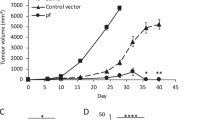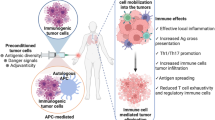Abstract
Several attempts to attack tumours in experimental systems have been made using conjugates of chemotherapeutic agents or potent toxins with antibodies (immunotoxins)1–8. In vitro studies have been highly successful, showing target specificity of a high order in some cases6–8. However, so far, such conjugates have been inadequate in vivo, probably for two main reasons. First, conventional heteroclonal antibodies are perhaps inappropriate, because purification by biochemical methods leaves a large amount of non-antibody γ-globulins. The use of monoclonal antibodies may overcome this problem. Second, when whole toxins have been conjugated to antibodies there has been a strong residual nonspecific cytotoxicity due to the binding capacity of a subunit, the B-piece of the toxin. (Diphtheria toxin or ricin consist of two polypeptide subunits. The A-piece is responsible for inhibition of protein synthesis on ribosomes, and the B-piece binds to galactose residues on the cell membrane and facilitates the transmembrane passage of the A-piece.) In the present work the problem of nonspecific binding by the B-piece has been circumvented by using the A-piece only as the toxin component of immunotoxins; these immunotoxins are active both in vitro and in vivo.
This is a preview of subscription content, access via your institution
Access options
Subscribe to this journal
Receive 51 print issues and online access
$199.00 per year
only $3.90 per issue
Buy this article
- Purchase on Springer Link
- Instant access to full article PDF
Prices may be subject to local taxes which are calculated during checkout
Similar content being viewed by others
References
Mathé, G., Loc, T. B. & Bernard, J. C. C. r. hebd. Séanc. Acad. Sci., Paris 246, 1626–1628 (1958).
Ghose, T. & Blair, A. H. J. natn. Cancer. Inst. 61, 657–672 (1978).
Davies, D. A. L. & O'Neill, G. J. Br. J. Cancer 28, Suppl.1, 285–298 (1973).
Arnon, R. Proc. Serono. Symp. 16, 287–304 (1979).
Moolten, F. L., Zajdel, S. & Cooperband, S. R. Ann. N. Y. Acad. Sci. 277, 690–699 (1976).
Thorpe, P. E. et al. Nature 271, 752–755 (1978).
Youle, R. J. & Neville, D. M. Jr. Proc. natn. Acad. Sci. U.S.A. 77, 5483–5486 (1980).
Jansen, F. K. et al. Immun. Lett. 2, 97–102 (1980); French Patent 78. 27. 838 (1978); U. S. Patent Application 79441 (1979).
Finney, D. J. in Probit Analysis 19–80 (Cambridge University Press, 1971).
Masuho, Y., Hara, T. & Noguchi, T. Biochem. biophys. Res. Commun. 90, 320–326 (1979).
Gilliland, D. G. et al. Proc. natn. Acad. Sci. U.S.A. 77, 4539–4543 (1980).
Krolick, K. A., Villemez, C., Isakson, P., Uhr, J. W. & Vitetta, E. S. Proc. natn. Acad. Sci. U.S.A. 77, 5419–5423 (1980).
Author information
Authors and Affiliations
Rights and permissions
About this article
Cite this article
Blythman, H., Casellas, P., Gros, O. et al. Immunotoxins: hybrid molecules of monoclonal antibodies and a toxin subunit specifically kill tumour cells. Nature 290, 145–146 (1981). https://doi.org/10.1038/290145a0
Received:
Accepted:
Issue Date:
DOI: https://doi.org/10.1038/290145a0
This article is cited by
-
Construction and characterization of the recombinant immunotoxin RTA-4D5-KDEL targeting HER2/neu-positive cancer cells and locating the endoplasmic reticulum
Applied Microbiology and Biotechnology (2018)
-
Gigantoxin-4-4D5 scFv is a novel recombinant immunotoxin with specific toxicity against HER2/neu-positive ovarian carcinoma cells
Applied Microbiology and Biotechnology (2016)
-
Alpha particles more promising than toxins?
European Journal of Nuclear Medicine and Molecular Imaging (2010)
-
Oriented immobilization of proteins
Mikrochimica Acta (1998)
Comments
By submitting a comment you agree to abide by our Terms and Community Guidelines. If you find something abusive or that does not comply with our terms or guidelines please flag it as inappropriate.



